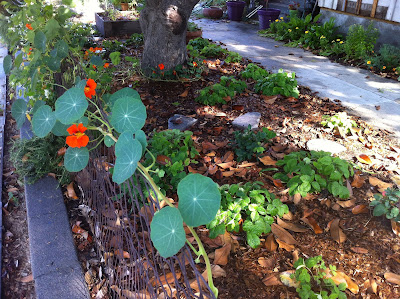when we first saw this house in april 2008,
i immediately fell in love with the large, shady magnolia tree
in front of the house.
it reminded me of arkansas, where i'm from.
in terms of landscaping, we didn't want any grass in the yard,
and our goal is an edible landscape.
so i wondered what to do underneath the magnolia tree,
which sits at the entrance to our home.
i was thumbing through the book, Landscaping with Fruit by Lee Reich,
and got inspired to do alpine strawberries.
so here it is, Mat 2010, right after I planted the alpine strawberries.
ryan had scored some free bales of hay,
and i was using that as a mulch.
and here it is, one year later.
i love the trailing nasturtium growing around the magnolia tree.
and the nasturtium draping over the fence.
but the best is going out to garden
and picking tiny, sweet alpine strawberries to snack on.









I love everything about your house! Magnolia trees are my favorite!
ReplyDeleteLOVE you and your house!! History buff that I am, I Googled your neighborhood and found *this!* Perfect for you sweet vegans. LOOK >
ReplyDeleteGarvanza is a neighborhood in northeast Los Angeles.
It is generally considered a subdistrict of Highland Park.
It is named for the GARBANZO BEANS that once flourished there.
(Which are central to my Spanish cooking btw!!)
Garvanza was annexed by the city in 1899.[1]
The two bridges which connect Los Angeles to South Pasadena originate in Garvanza. The railroad bridge has been rebuilt twice since the early part of the last century, and the York Street bridge, one of the most picturesque to span the Arroyo Seco, was built to replace a small wooden toll bridge that became too rickety to support the ever increasing traffic between South Pasadena and Los Angeles. The toll house still exists on the South Pasadena side.
Garvanza , like neighboring Eagle Rock and Hermon, were incorporated into the city of Los Angeles very early in the 20th century. Garvanza received LA Rail service first in 1903 [1] and was one of the first parts of Los Angeles to be electrified.
The world famous Judson Studios, built in 1911, and creators of much of the remarkable stained glass that graced Craftsman and Mission structures throughout the SoCal region, are located in Garvanza at 200 South Avenue 66. They are the oldest family-run art glass company in the United States. They created many of the art glass applications and installations for Frank Lloyd Wright in California.
Garvanza, along with South Pasadena and Pasadena, is generally considered to be the birthplace of the Arts & Crafts movement in Southern California.
Thanks, Amy!
ReplyDeleteLee, that is such a hoot! I always wondered why this neighborhood was called Garvanza. Now I'm gonna grow garbanzo beans next year. :)
That is the sweetest bed of berries ever and a truly brilliant idea.
ReplyDeleteGotta love blogging, right?
Oh the places we go:)
xo Jane
Brilliant! I'm constantly amazed at all your great ideas!
ReplyDeleteImagine how fabulous this will be in a couple of years when the whole area is filled through and through!
jane and sarah - thank you! i'm always inspired by both of your blogs.
ReplyDeleteI can't wait until it is a mass of green underneath the magnolia. :)
Yes, indeedy! In my family Garbanzos are pronounced Gar-van-thos from the Spanish of Spain. My grandfather would have loved your home and garden. He (Bibiano) and my abuelita (Grandma Argie - for Argentina!) would buy old houses, remodel them so that they looked like the tidy homes in Spain - knocking out walls for big spaces in which to dance and creating patios and gardens with lots of flowers, tomatoes, onions, garlic and peppers, which are the staples of yummy Spanish cooking. You and your place have inspired me to spend more of my time in my little garden!
ReplyDeleteBeautiful. Magnolia blooms are my absolute favourite.
ReplyDelete